The 2016-17 season was supposed to be a growing one for the Philadelphia Flyers.
A surprising, yet short, playoff run in 2016, offseason signings like Dale Weise and the influx of rookies in Travis Konecny and Ivan Provorov increased expectations for the Flyers before the season started. In season, a 10-game winning streak in December kept the expectations alive after an inconsistent start.
Four months later, the playoff expectations seem like silly dreams as Philly plays out the remaining bit of its schedule. The team was officially eliminated Sunday after a loss to the New York Rangers, but the hope—the actual belief—that the Flyers could make it back died after they lost to the Toronto Maple Leafs and Boston Bruins, back-to-back, in early March.
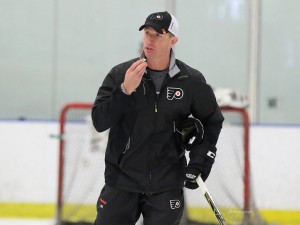
There are plenty of things that can be blamed for Philly’s failures. Weak goaltending, abysmal offense and improved play from other Eastern Conference teams (such as the Bruins, Maple Leafs, and Columbus Blue Jackets) are a few reasons that sunk the Flyers over the season.
A big reason that most fans point at first is the man who coached them to the surprising playoff berth last year: Dave Hakstol. From his lineup choices to his system, the second-year coach has been critiqued often this year.
But it may have been the Flyers’ management, Ron Hextall and company, that might have cost the team another playoff run. The choice to not insulate Hakstol with a veteran coach may have been that mistake.
Dave Hakstol’s Hiring and First Year
In May of 2015, the Flyers hired Hakstol, nabbing a coach from North Dakota University of the NCAA with no NHL coaching experience. It was the first time in 33 years that had happened.
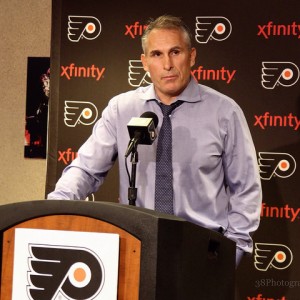
When Craig Berube was fired about a month earlier, his assistant coaches Ian Laperriere and Gord Murphy remained on staff. Most thought a coach with NHL experience would come in to help Hakstol in a mentoring role.
Whether the organization felt they were comfortable enough or didn’t want Hakstol to feel pressure from a more experienced coach, the Flyers stuck with Laperriere and Murphy. Either way, most were expecting a rebuilding year from Philadelphia.
It started out that way, but quickly after the new year, the Flyers started gaining steam, mainly because rookie Shayne Gostisbehere seemed to be the gasoline that was missing in the Philadelphia fire.
Hakstol’s system also helped. It called for a strong focus on defense, which held back captain Claude Giroux and others, but paid dividends on the team’s record. The power play was also one of the best in the league, while the team carried an unimpressive even-strength attack.
The Flyers made the playoffs and although they were outmatched by the Presidents’ Trophy-winning Washington Capitals, a veteran coach on the bench didn’t seem to be missing from the formula.
Hakstol’s 2016-17
The 2016-17 Flyers were a much different team than the one from the previous year. This team had expectations, but it also had rookies entering the lineup who were younger than Gostisbehere.
Most figured that with Hakstol’s experience molding and working with young players at North Dakota, there would be no issues. It wasn’t long before problems actually began.
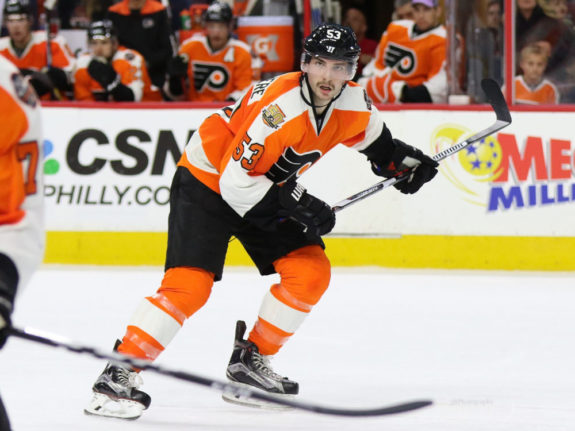
It wasn’t Konecny or Provorov at first, though. Gostisbehere had somewhat of a sophomore slump. Although not a liability on the ice, the 23-year-old struggled to create offense off transitions or be a force offensively.
Hakstol made the decision to healthy scratch him in the middle of November, the first time ever for Gostisbehere. But it was a three-game benching in February that enraged most fans.
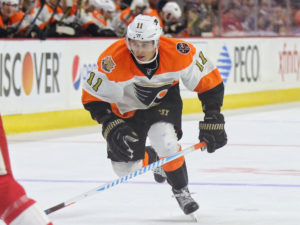
At the same time, Konecny was being held out of the lineup for the second time in the season. Since then, he’s played from the fourth line to the first line and at some points as little as eight minutes of ice time.
There’s no doubt the two make mistakes. Every player does and especially younger players. However, there’s also no doubt that the pair is two of the Flyers’ best players who should never sit for consecutive games or be put in non-offensive roles.
It’s possible that a more experienced coach that has dealt with the ebbs and flows of an NHL rookie could have guided Hakstol better.
Then there’s the issue with goalie playing time. Hakstol rode Steve Mason during the 10-game winning streak while Michal Neuvirth was out.
He had his reasons for doing that, but the Flyers learned last year that Mason can and will slow down if he plays too many games like he did down the stretch last season.
Good judgment comes from experience, and experience comes from bad judgment, but it’s possible that maybe some of the bad judgments from this year could have been prevented. Unfortunately for the Flyers, Hakstol didn’t have the NHL experience necessary.
Hakstol’s & Flyers’ Future
Most Flyers fans would like to see Hakstol not be a part of the team’s future. With the success he had last season, I believe he’s bought himself at least another half of a season.
More importantly, though, the mistake the Flyers made by not bringing in a seasoned assistant coach can be rectified. Laperriere has failed to turn Philly’s penalty kill to even average, while the defense led by Murphy this season was just average.
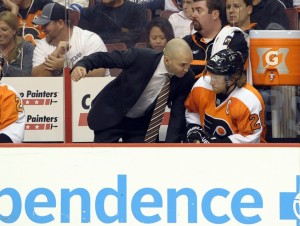
That means the removal of one or both isn’t totally out of the question. If that does happen, there’s really only one way to go.
Finding an experienced coach won’t be difficult. There are plenty on the market and there will be more once the season ends. The organization also has former New York Islanders coach Scott Gordon coaching the Phantoms, who could be promoted.
One of the biggest issues with this proposal is that there will be more pressure than ever before on Hakstol with a former NHL head coach on his bench. With this past season, though, the 48-year-old coach should be expecting some heat from management.
The Flyers will have rookies joining the team over the next few years. What happened this year cannot be duplicated. Maybe a more experienced assistant coach helps guide that. And even if he doesn’t, the replacement’s there just in case.